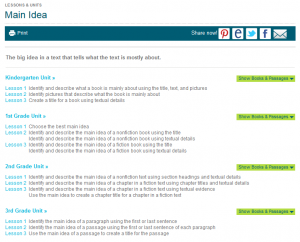Common Core Reading Lessons: Main Idea
 The big idea in a text that tells what the text is mostly about.
The big idea in a text that tells what the text is mostly about.
Main Idea Lessons - Covers kindergarten through sixth grade. Examples: Identify and describe what a book is mainly about using the title, text, and pictures. Identify and describe the main idea of a nonfiction book using textual details. Use the main idea to create a chapter title for a chapter in a fiction text. Identify the main idea of a paragraph using the first or last sentence. Distinguish main details from secondary details in a paragraph.
Craft and Structure
CCSS.ELA-Literacy.RL.K.6 With prompting and support, name the author and illustrator of a story and define the role of each in telling the story.
Key Ideas and Details
CCSS.ELA-Literacy.RI.K.2 With prompting and support, identify the main topic and retell key details of a text.
Key Ideas and Details
CCSS.ELA-Literacy.RL.1.1 Ask and answer questions about key details in a text.
CCSS.ELA-Literacy.RL.1.2 Retell stories, including key details, and demonstrate understanding of their central message or lesson.
Integration of Knowledge and Ideas
CCSS.ELA-Literacy.RL.1.7 Use illustrations and details in a story to describe its characters, setting, or events.
Comprehension and Collaboration
CCSS.ELA-Literacy.SL.2.2 Recount or describe key ideas or details from a text read aloud or information presented orally or through other media.
Key Ideas and Details
CCSS.ELA-Literacy.RI.3.1 Ask and answer questions to demonstrate understanding of a text, referring explicitly to the text as the basis for the answers.
CCSS.ELA-Literacy.RI.3.2 Determine the main idea of a text; recount the key details and explain how they support the main idea.
Craft and Structure
CCSS.ELA-Literacy.RI.3.4 Determine the meaning of general academic and domain-specific words and phrases in a text relevant to a grade 3 topic or subject area.
Range of Reading and Level of Text Complexity
CCSS.ELA-Literacy.RI.3.10 By the end of the year, read and comprehend informational texts, including history/social studies, science, and technical texts, at the high end of the grades 2-3 text complexity band independently and proficiently.
Fluency
CCSS.ELA-Literacy.RF.3.4 Read with sufficient accuracy and fluency to support comprehension.
CCSS.ELA-Literacy.RF.3.4a Read on-level text with purpose and understanding.
CCSS.ELA-Literacy.RF.3.4c Use context to confirm or self-correct word recognition and understanding, rereading as necessary.
Text Types and Purposes
CCSS.ELA-Literacy.W.3.2 Write informative/explanatory texts to examine a topic and convey ideas and information clearly.
CCSS.ELA-Literacy.W.3.2d Provide a concluding statement or section.
Comprehension and Collaboration
CCSS.ELA-Literacy.SL.3.2 Determine the main ideas and supporting details of a text read aloud or information presented in diverse media and formats, including visually, quantitatively, and orally.
Vocabulary Acquisition and Use
CCSS.ELA-Literacy.L.3.4 Determine or clarify the meaning of unknown and multiple-meaning word and phrases based on grade 3 reading and content, choosing flexibly from a range of strategies.
CCSS.ELA-Literacy.L.3.4a Use sentence-level context as a clue to the meaning of a word or phrase.
CCSS.ELA-Literacy.L.3.5 Demonstrate understanding of word relationships and nuances in word meanings.
CCSS.ELA-Literacy.L.3.5b Identify real-life connections between words and their use (e.g., describe people who are friendly or helpful).
CCSS.ELA-Literacy.L.3.6 Acquire and use accurately grade-appropriate conversational, general academic, and domain-specific words and phrases, including those that signal spatial and temporal relationships (e.g., After dinner that night we went looking for them).
Text Types and Purposes
CCSS.ELA-Literacy.W.4.2 Write informative/explanatory texts to examine a topic and convey ideas and information clearly.
CCSS.ELA-Literacy.W.4.2b Develop the topic with facts, definitions, concrete details, quotations, or other information and examples related to the topic.